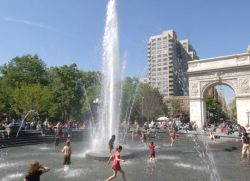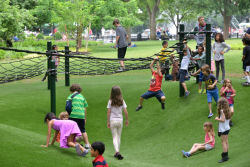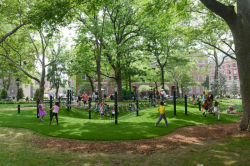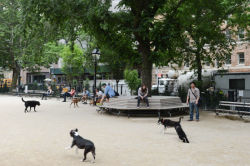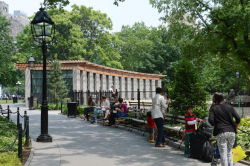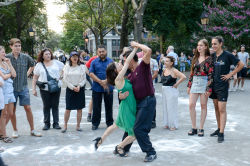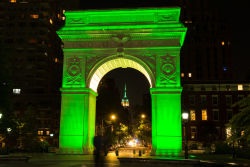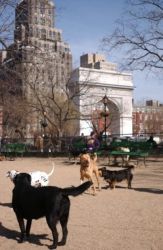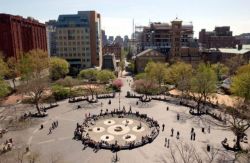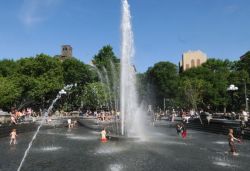Washington Square Park
The Daily Plant : Tuesday, November 12, 2002
NOVEMBER CAPITAL PROJECT OF THE MONTH: BROWER PARK PLAYGROUND
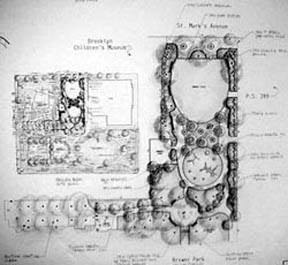
The Capital Project of the Month for November is the Brower Park Playground. Funded by Council Member Albert Vann, this $692,000 project will transform the playground into a more modern and safer play area. The playground is in the Crown Heights section of Brooklyn, between the Brooklyn Children’s Museum and P.S. 289.
The design, by Parks’ own Tom Cleveland, will maintain an open assembly and play area for school children and create a new play area, connecting the two spaces with a wooded play area through which children can run.
Two main elements, inspired by the Brooklyn Children’s Museum, are a thumb piano and a spiraling spray shower. The thumb piano originated in Africa and was a hand-held musical instrument made from a wooden box or hollow gourd. The sound was created by pieces of hammered metal, like nails, that when plucked, would vibrate, creating a sound in a similar way to that of a guitar. The new design enlarges the thumb piano from a hand- held item to a stationary musical instrument which two children can simultaneously play.
The first step in creating the thumb piano was to make a small scale wax model which was used in generating computer drawings. Then a full size plaster model was made. This model will be used as the pattern in the casting process. The method of casting is called the "French sand casting method." The sand, which was originally found in France, is used to make the molds in which the hot molten bronze is poured. The sand is recyclable and no rubber or plaster molds need to be made. The cost of casting is much less expensive than the typical lost wax-bronze casting method. This particular type of casting has been used for centuries and many of the European church bells were cast in this method.
A new spray shower area serving the entire park is in the design and will have a spiraling water spray feature at its center. This form for the spiral was inspired by many of the shells found in the Brooklyn Children’s Museum. For the shower, first a plaster small-scale model was made; then 3-D computer drawings were made which were used to make a full size styrofoam and plaster model. This plaster model will be used as the pattern in the French sand casting method as described above. When installed the water will spray up into the air and a stream of water will flow around the spiral.
Brower Park is 7 acres and was named after Parks Commissioner George V. Brower in 1923. Although he was born in Paterson, New Jersey, Brower was a member of an old Brooklyn family. He served as an apprentice to a Pennsylvania judge and moved to Brooklyn in 1867 to practice law. Brower was General Appraiser of the Port of New York from 1880 to 1884, and he was a Parks Commissioner from 1889 to 1894 and from 1898 to 1901. He was instrumental in acquiring Red Hook, Fort Hamilton, and Sunset Parks in Brooklyn and "Brooklyn Forest," now Forest Park in Queens. Brower died in his home, at 1084 Park Place directly south of the Brower Park, in 1921.
THIRTEEN YEARS AGO IN THE PLANT
(Tuesday, November 22, 1989)
JUST HANGING AROUND WASHINGTON SQUARE
Parks officials and members of the Parks Council went to Washington Square Park yesterday to see the Hangman’s Elm, the most notorious plant in New York since the man-eating Audrey II in "Little Shop of Horros."
The 70—foot-tall English elm (Ulmus procera) at the corner of Waverly Place and MacDougal Street, acquired its reputation during the American Revolutionary War. According to legend, traitors were hung from its branches. Estimated to be 300 years old, the tree has a diameter of 61 inches.
QUOTATION FOR THE DAY
"There is a continual exchange of ideas between all minds of a generation. Journalists, popular novelists, illustrators, and cartoonists adapt the truths discovered by the powerful intellects for the multitude.
It is like a spiritual flood, like a gush that pours into multiple cascades until it forms the great moving sheet of water that stands for the mentality of a period."
Auguste Rodin
(November 12, 1849–1917)


